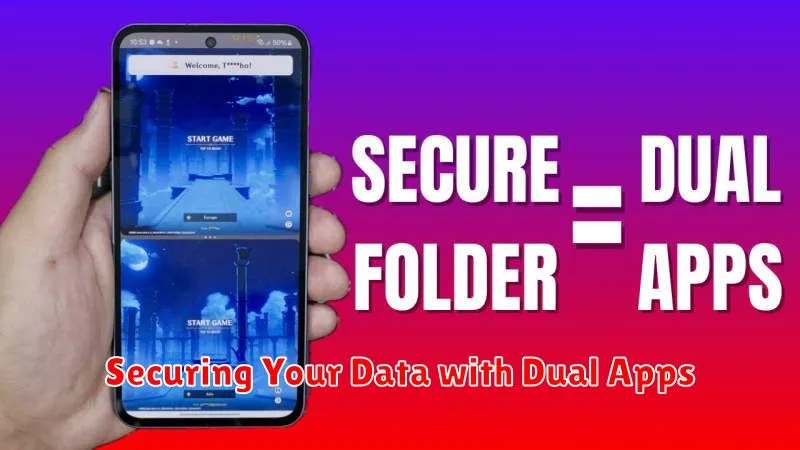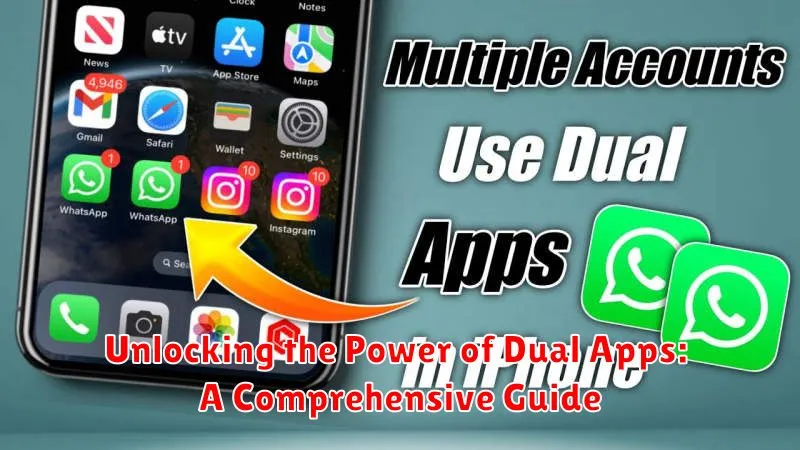In today’s fast-paced digital world, managing multiple accounts across various platforms has become increasingly common. Whether it’s for personal use, professional endeavors, or maintaining separate identities for gaming or social media, the need to juggle multiple accounts can be overwhelming. This is where the power of dual apps comes into play. Dual apps, also known as app cloners or parallel space apps, allow users to create and manage two separate instances of the same application on a single device. This comprehensive guide will delve into the intricacies of dual apps, exploring their functionality, benefits, and how they can streamline your digital life.
This guide will unlock the power of dual apps by providing a comprehensive overview of their capabilities and advantages. Learn how dual apps can enhance productivity by enabling users to seamlessly switch between work and personal accounts without the hassle of logging in and out repeatedly. Discover how dual apps can protect privacy by creating separate spaces for sensitive information. This guide will also cover the various types of dual apps available, their compatibility with different operating systems, and address potential security concerns. By the end of this guide, you will have a thorough understanding of how to effectively utilize dual apps to optimize your digital experience.
Understanding the Benefits of Dual Apps
Dual apps offer a range of advantages for both personal and professional use. Separating work and personal accounts on the same device is a key benefit. This allows users to maintain distinct profiles for each, enhancing privacy and organization.
Managing multiple social media accounts is another compelling reason to use dual apps. Users can easily switch between different profiles without the hassle of logging in and out repeatedly. This is particularly useful for social media managers or individuals with multiple business accounts.
Dual apps also facilitate accessing region-specific content. By using separate app instances with different regional settings, users can access content and services otherwise unavailable in their current location. This can be beneficial for accessing geographically restricted games or streaming services.
Testing and development benefit from dual app functionality as well. Developers can utilize dual apps to test different versions of their applications simultaneously on a single device. This streamlines the testing process and allows for more efficient debugging.
Setting Up Dual Apps on Your Device
The process for setting up dual apps varies depending on your device’s operating system and manufacturer. Most Android devices offer built-in functionality for creating app clones. Look for features like “Dual Apps,” “App Twin,” or “Parallel Space” within your phone’s settings. These options usually reside in the “Apps,” “Advanced Features,” or a similarly named section.
To activate a dual app, simply select the app you wish to duplicate from the list of available applications. The system then creates a second, independent instance of the app, identifiable by a badge or modified icon. This cloned app operates separately from the original, with its own data and settings.
For devices without built-in dual app functionality, third-party apps from the app store can provide similar capabilities. These apps often offer additional customization options. However, it’s important to carefully review permissions requested by these apps before installation.
Managing Notifications and Permissions for Dual Apps
Dual apps often require specific notification and permission settings to function correctly and maintain user privacy. It’s crucial to understand how to manage these settings effectively.
Each dual app instance operates independently, meaning you can customize notification behavior for each. For example, you might enable sound notifications for your personal social media app while silencing them for your work account.
Permissions also require careful management. Granting access to contacts, location, or storage should be considered on a per-app basis. You may want to restrict certain permissions for the cloned app to enhance security and protect your personal data.
Most devices offer granular control over these settings. You can usually find these controls within the device’s settings menu, under the “Apps” or “Dual Apps” section.
Reviewing and adjusting these settings regularly ensures a seamless and secure dual app experience. Be mindful of the permissions requested by each instance and tailor them to your specific needs.
Troubleshooting Common Dual App Issues
While dual apps offer incredible convenience, users occasionally encounter issues. This section addresses common problems and provides solutions.
App Crashes or Freezes
App instability in the cloned app can stem from resource conflicts. Try clearing the cloned app’s cache or data. If the problem persists, ensure your device’s operating system is up-to-date.
Notification Problems
Missing notifications can occur if notification permissions aren’t properly configured for the cloned app. Verify these settings within the dual app management section of your device.
Login Issues
Some apps with strict security measures might flag login attempts from cloned apps as suspicious. If you face login issues, try contacting the app’s support team for assistance.
Data Synchronization Errors
Inconsistent data between the original and cloned app can be a sign of synchronization issues. Check the app’s data synchronization settings and ensure a stable network connection.
Tips for Optimizing Dual App Performance

Running dual apps can sometimes put a strain on your device’s resources. Optimizing their performance ensures a smooth user experience. Here are some helpful tips:
Close Unused Apps: Background apps consume resources. Close any apps you’re not actively using in either instance to free up memory and processing power for your dual apps.
Clear App Cache Regularly: Cached data can accumulate and slow down performance. Regularly clear the cache for both instances of your dual apps to maintain optimal speed. You can typically do this within your device’s settings.
Monitor Data Usage: Dual apps can consume more mobile data. Keep track of your data usage to avoid exceeding your limits and incurring extra charges. Consider connecting to Wi-Fi whenever possible, especially for data-intensive activities like streaming or downloading.
Restart Your Device: A simple restart can often resolve performance issues. If your dual apps are running sluggishly, try restarting your device to refresh its resources.
Update Your Apps: Developers frequently release updates that include performance improvements and bug fixes. Ensure you have the latest versions of your dual apps installed.
Exploring Advanced Dual App Features
Beyond the basic functionality of running two instances of an app, some dual app implementations offer advanced features that enhance user experience and customization. App-specific settings allow users to tailor each instance independently. This might include adjusting notification preferences, data usage limits, or even applying different themes.
Secure folders or workspaces integrate with dual app functionality to provide isolated environments for sensitive data. This adds an extra layer of security for personal or work accounts accessed through cloned apps.
Some dual app implementations support inter-app communication between the two instances. This can be particularly useful for transferring data or sharing files quickly and efficiently without leaving the dual app environment.
Comparing Different Dual App Implementations
Dual app functionality isn’t a monolithic feature. Different manufacturers and operating systems offer varying implementations, each with its own strengths and weaknesses. Understanding these differences is crucial for selecting the right approach for your needs.
Built-in OS-Level Support: Some operating systems, like certain Android distributions, offer native dual app capabilities. This often means tighter integration with the system, potentially leading to better performance and stability. However, the features offered might be limited compared to third-party solutions.
Third-Party Apps: Numerous apps available on app stores allow for dual app creation. These often offer a wider range of customization options, such as individual notification settings and storage management. However, compatibility and performance can vary depending on the app and device.
Work Profile/Work Space: Primarily aimed at separating personal and professional data, this approach creates a completely separate environment on your device. It provides robust security features but might be less suitable for casual dual app usage.
App Cloning: This method creates a separate, independent copy of an existing app. While simple to use, cloned apps may not be as seamlessly integrated as other implementations, potentially leading to issues with syncing and notifications.
Securing Your Data with Dual Apps

While dual apps offer incredible convenience, maintaining data security is paramount. Protecting your information across two instances of an app requires careful consideration.
Strong passwords are crucial. Employ unique, complex passwords for each app instance, especially if one is dedicated to personal use and the other for work or other sensitive activities. Avoid using the same password for both instances.
Be mindful of the permissions granted to each dual app. Review the permissions requested and ensure they align with the app’s intended function. Restrict access to sensitive data like contacts or location if not essential for the app’s operation.
Two-factor authentication (2FA) provides an extra layer of security. Whenever available, enable 2FA on both instances of the dual app. This ensures that even if a password is compromised, unauthorized access is still prevented.

